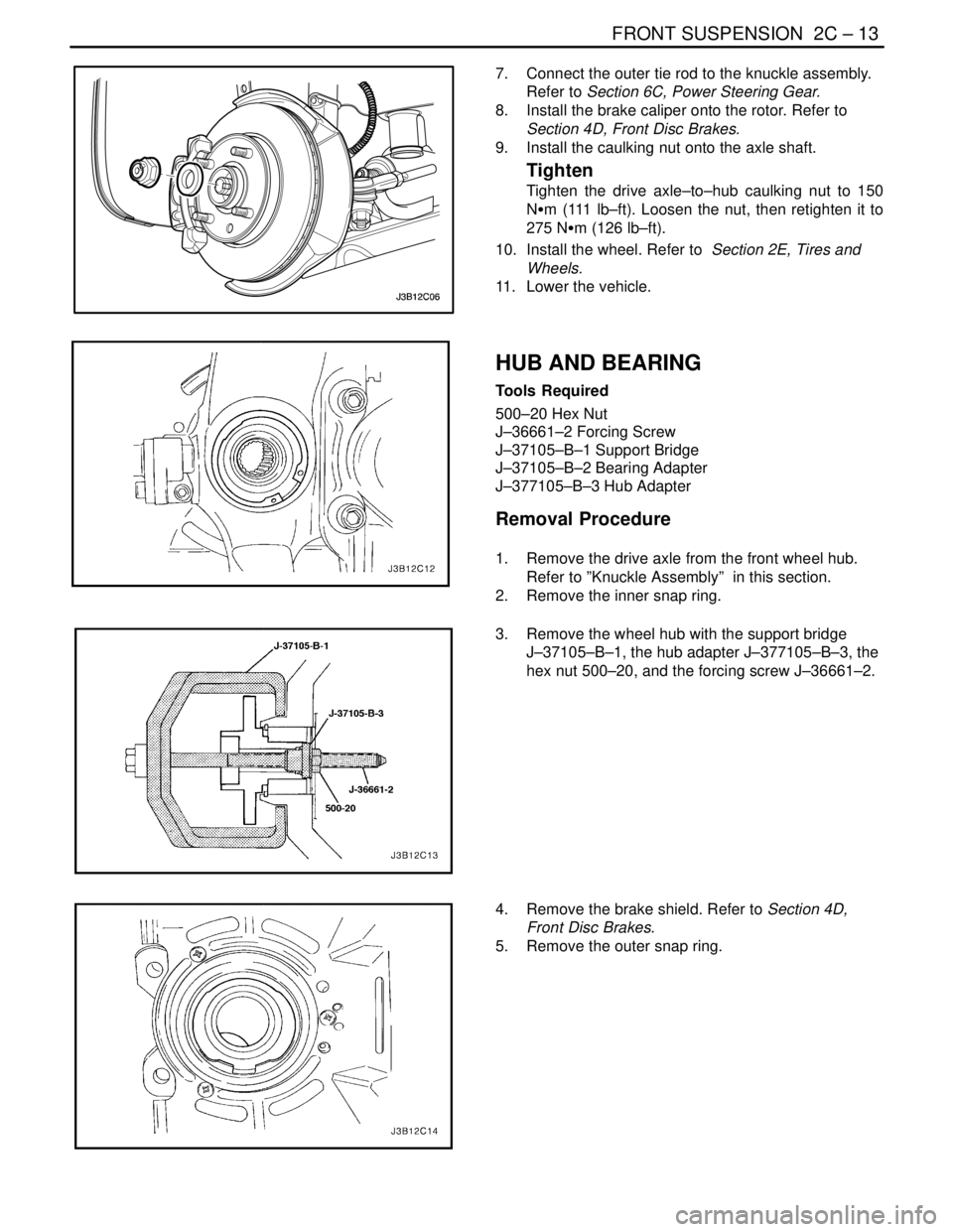Page 919 of 2643
2C – 2IFRONT SUSPENSION
DAEWOO V–121 BL4
SPECIFICATIONS
GENERAL SPECIFICATIONS
ApplicationTrim Height
Center of Front Wheel to Bottom of Front Wheel Well368 mm (14.4 in.)
Center of Rear Wheel to Bottom of Rear Wheel Well367 mm (14.4 in.)
* CONDITION : Full Fuel in the Tank
FASTENER TIGHTENING SPECIFICATIONS
ApplicationNSmLb–FtLb–In
Ball Joint Pinch Bolt Nut6044–
Ball Joint–to–Control Arm Nuts10074–
Front Control Arm–to–Crossmember Bolt12592–
Rear Contral Arm–to–Crossmember Bolt11 081–
Crossmember Link–to–Crossmember Bolt11 484–
Crossmember Link–to–Transaxle Bracket Nut169125–
Drive Axle–to–Hub Caulking Nut300221–
Front Crossmember–to–Body Bolts13096–
Piston Rod Nut7555–
Rear Crossmember–to–Body Bolts196145–
Stabilizer Link–to–Strut Assembly Nut4735–
Stabilizer Shaft–to–Crossmember Clamp Bolts2518–
Stabilizer Shaft–to–Stabilizer Link Nut4735–
Steering Knuckle–to–Strut Assembly Nuts/Bolts12089–
Strut Assembly–to–Body Nut6548–
Page 929 of 2643

2C – 12IFRONT SUSPENSION
DAEWOO V–121 BL4
Notice : Do not over extend the axle joints. When either
end of the shaft is disconnected, overextension of the joint
can result in separation of internal components and pos-
sible joint failure. Use drive axle joint seal protectors when-
ever performing service on or near the drive axles. Failure
to do so can cause internal joint or seal damage and result
in possible joint failure.
10. Support the drive axle.
11. Separate the drive axle shaft from the wheel hub.
12. Remove the bolts that connect the knuckle assem-
bly to the strut assembly.
13. Remove the knuckle assembly from the vehicle.
Installation Procedure
1. Install the knuckle assembly onto the vehicle.
2. Install the steering knuckle–to–strut assembly nuts.
Tighten
Tighten the steering knuckle–to–strut assembly nuts
to 120 NSm (89 lb–ft).
3. Connect the drive axle to the front wheel hub.
4. Connect the ball joint to the knuckle assembly.
5. Install the ball joint pinch bolt and the nut.
Tighten
Tighten the ball joint pinch bolt nut to 60 NSm (44 lb–
ft).
6. Connect the ABS speed sensor electrical connec-
tion.
Page 930 of 2643

FRONT SUSPENSION 2C – 13
DAEWOO V–121 BL4
7. Connect the outer tie rod to the knuckle assembly.
Refer to Section 6C, Power Steering Gear.
8. Install the brake caliper onto the rotor. Refer to
Section 4D, Front Disc Brakes.
9. Install the caulking nut onto the axle shaft.
Tighten
Tighten the drive axle–to–hub caulking nut to 150
NSm (111 lb–ft). Loosen the nut, then retighten it to
275 NSm (126 lb–ft).
10. Install the wheel. Refer to Section 2E, Tires and
Wheels.
11. Lower the vehicle.
HUB AND BEARING
Tools Required
500–20 Hex Nut
J–36661–2 Forcing Screw
J–37105–B–1 Support Bridge
J–37105–B–2 Bearing Adapter
J–377105–B–3 Hub Adapter
Removal Procedure
1. Remove the drive axle from the front wheel hub.
Refer to ”Knuckle Assembly” in this section.
2. Remove the inner snap ring.
3. Remove the wheel hub with the support bridge
J–37105–B–1, the hub adapter J–377105–B–3, the
hex nut 500–20, and the forcing screw J–36661–2.
4. Remove the brake shield. Refer to Section 4D,
Front Disc Brakes.
5. Remove the outer snap ring.
Page 935 of 2643

2C – 18IFRONT SUSPENSION
DAEWOO V–121 BL4
3. Connect the stabilizer shaft link to the strut assem-
bly by attaching the stabilizer link–to–strut assem-
bly nut.
Tighten
Tighten the stabilizer link–to–strut assembly nut to 47
NSm (35 lb–ft).
4. Install the brake line to the securing bracket on the
strut assembly.
5. On vehicles equipped with the ABS, connect the
ABS sensor line to the strut assembly.
6. Install the wheel. Refer to Section 2E, Tires and
Wheels.
7. Lower the vehicle.
8. Install the nuts securing the strut assembly to the
body of the vehicle.
Tighten
Tighten the strut assembly–to–body nuts to 65 NSm
(48 lb–ft).
CROSSMEMBER ASSEMBLY
Removal Procedure
1. Raise and suitably support the vehicle.
2. Remove the wheels. Refer to Section 2E, Tires and
Wheels.
3. Remove the nuts and bolts from the steering gear
mounting bracket.
4. Remove the return line bolt from the clip on the
crossmember.
5. Remove the exhaust pipe forward of the catalytic
converter. Refer to Section 1G, Engine Exhaust.
6. Disconnect the tie rod from the knuckle assembly.
Refer to Section 6C, Power Steering Gear.
7. Disconnect the ball joint from the knuckle assembly.
Refer to ”Knuckle Assembly” in this section.
8. Disconnect the stabilizer link from the strut assem-
bly. Refer to ”Stabilizer Link” in this section.
9. Remove the crossmember link–to–transaxle brack-
et nut.
1) Remove the right lower engine mount.
2) Remove the rear transmission mount bracket.
Page 937 of 2643
2C – 20IFRONT SUSPENSION
DAEWOO V–121 BL4
6. Install the crossmember link–to–transaxle bracket
nut.
Tighten
Tighten the crossmember link–to–transaxle bracket
nut to 169 NSm (125 lb–ft).
7. Connect the stabilizer link to the strut assembly.
Refer to ”Stabilizer Link” in this section.
8. Connect the ball joint to the knuckle assembly. Re-
fer to ”Knuckle Assembly” in this section.
9. Connect the tie rod from the knuckle assembly. Re-
fer to Section 6C, Power Steering Gear.
10. Install the exhaust pipe into the vehicle. Refer to
Section 1G, Engine Exhaust.
11. Install the wheels. Refer to Section 2E, Tires and
Wheels.
12. Lower the vehicle.
Page 942 of 2643

FRONT SUSPENSION 2C – 25
DAEWOO V–121 BL4
GENERAL DESCRIPTION
AND SYSTEM OPERATION
FRONT SUSPENSION
The front suspension for this vehicle is a combination of
a strut assembly and a knuckle assembly. The strut as-
sembly combines a strut dampener and spring mounted
to the body of the vehicle. The upper end of the strut is iso-
lated by a rubber mount and contains a bearing to allow the
strut to turn. The knuckle is attached to the strut assembly
and pivots on a ball joint bolted to the control arm. The con-
trol arms pivot from the body using rubber bushings.
The ball joint is fastened to the steering knuckle with a
pinch bolt and nut, and to the lower control arm with rivets.
The stabilizer bar interconnects both strut assemblies ofthe vehicle through the stabilizer link and is attached to the
front suspension crossmember. Jounce and rebound
movements affecting one wheel are partially transmitted
to the opposite wheel of the vehicle to stabilize body roll.
When servicing the control arm–to–body attachment and
the stabilizer shaft–to–body insulators, make sure the at-
taching bolts are loose until the control arms are moved to
the trim height, which is curb height. Trim height is the nor-
mal position to which the control arms move when the ve-
hicle is sitting on the ground. Refer to ”General Specifica-
tions” in this section.
The springs in the front suspension of engine family II are
stronger and the strut dampeners heavier than are the
springs and strut dampeners found in the front suspension
of engine family I.
Page 973 of 2643

TIRES AND WHEELS 2E – 11
DAEWOO V–121 BL4
pacity, diameter, rim width, offset, and mounting configu-
ration. A wheel of improper size or type may affect wheel
and bearing life, brake cooling, speedometer/odometer
calibration, vehicle ground clearance, and tire clearance
to the body and the chassis. The wheel offset is 49 ± 1 mm
(1.93 ± 0.04 inches). Steel wheels may be identified by a
two– or three–letter code stamped into the rim near the
valve stem. Alloy wheels should have the code, the part
number, and the manufacturer ID cast into the back side.
INFLATION O TIRES
The pressure recommended for any vehicle line is careful-
ly calculated to give a satisfactory ride, handling, tread life,
and load–carrying capacity.
Tire pressure should be checked monthly or before any
extended trip. Check the tires when they are cold, after the
vehicle has sat for 3 hours or more, or has been driven less
than 1 mile. Set the tire pressure to the specifications on
the tire label located on the rear face of the driver’s door.
Tire inflation pressure is also given under ”Tire Size and
Pressure Specifications” in this section.
Valve caps or extensions should be on the valves to keep
dust and water out.
For sustained driving at speeds up to 140 km/h (85 mph),
inflate the tires to the pressure recommended on the tire.
Sustained driving at speeds faster than 140 km/h (85mph), even if permitted by law, is not advised unless the
vehicle has special high–speed tires available from many
tire dealers. Tire pressures may increase as much as 41
kPa (6 psi) when the tires are hot.
Higher than recommended tire pressure can cause
S Hard ride.
S Tire bruising or damage.
S Rapid tread wear at the center of the tire.
Lower than recommended pressure can cause
S Tire squeal on turns.
S Hard steering.
S Rapid and uneven wear on the edges of the tread.
S Tire rim bruises and rupture.
S Tire cord breakage.
S High tire temperatures.
Unequal tire pressures on same axle can cause
S Uneven braking.
S Steering lead.
S Reduced handling.
S Swerve on acceleration.
S Torque steer.
Page 993 of 2643
3A – 4IAUTOMATIC TRANSAXLE DRIVE AXLE
DAEWOO V–121 BL4
MAINTENANCE AND REPAIR
ON–VEHICLE SERVICE
DRIVE AXLE ASSEMBLY
Tools Required
KM–507–B Ball Joint Separator
DW340–110 Axle Shaft Remover
Removal Procedure
1. Raise and suitably support the vehicle.
2. Remove the wheels. Refer to Section 2E, Tires
and Wheels.
3. Remove the axle shaft caulking nut. Discard the
nut.
Notice : Use only the recommended tool for separating
the lower ball joint. Failure to use the recommended tool
may cause damage to the ball joint and the seal.
4. Remove the lower ball joint pinch bolt and nut.
5. Separate the steering knuckle from the lower ball
joint using the ball joint separator KM–507–B.
6. Remove the tie rod nut.
Notice : Use only the recommended tool for separating
the tie rod from the knuckle/strut assembly. Failure to use
the recommended tool may cause damage to the knuckle/
strut assembly.
7. Separate the tie rod end using the ball joint separa-
tor KM–507–B.